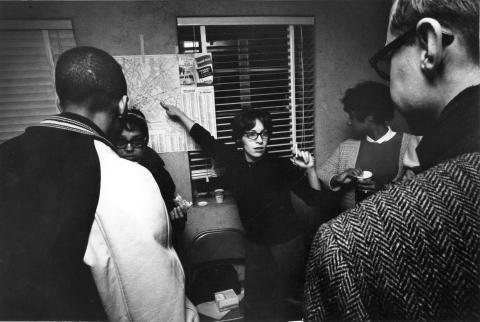
Today's image from our archives is a photograph taken by photojournalist Dennis Brack (1939- ) from the headquarters of a Student Nonviolent Coordinating Committee (SNCC) led protest in Washington, D.C. In 1965, SNCC organized with local anti-poverty activists and other civil rights workers to protest a fare hike by the city's Metro Area Transit Commission.
The campaign began on November 8, 1965, during a hearing for the proposal, which was attended by over 100 SNCC-organized opponents of the plan, who announced that, unless plans to raise rates were abandoned, the city could expect a transit boycott.
On January 24, 1966, SNCC, along with local churches and organizations like Americans for Democratic Action, Congress of Racial Equality, and the Coalition of Conscience began a boycott campaign. The campaigners distributed leaflets and organized "freedom busses", rideshares, and other alternate transportation.
The one-day boycott withdrew an estimated 150,000 riders from the transit system, costing the city $30,000 and leading to road conditions that required city police to distribute officers to streets to assist in directing traffic. In the aftermath, traffic officials abandoned plans for the fare increase, which did not go into effect.
This photograph is part of Hagley Library's collection of Chamber of Commerce of the United States photographs and audiovisual materials, Series II. Nation's Business photographs (Accession 1993.230.II). This series contains more than 15,000 original photographs that were taken for publication in the the Chamber of Commerce of the United States' magazine, Nation's Business. The images date from the 1890s to 2004, with a bulk of the material dating from the 1940s through the 1960s.
The Chamber of Commerce of the United States is the world’s largest business organization representing the interests of more than 3 million businesses of all sizes, sectors, and regions. Chamber members range from small businesses and local chambers to leading industry associations and large corporations. The Chamber traces its origins to an April 22, 1912, conference of commercial and trade organizations called by President William Howard Taft. The goal was to form a national group to advise the government on issues facing industry and business throughout the country.
Nation’s Business was a monthly publication from the Chamber of Commerce of the United States. The Chamber used the publication to inform the business community about commercial trends and to solidify political support around key positions on government policies regarding business and economic life.
This photograph appeared in a March 1966 issue of Nation's Business in an article titled "Is War on Poverty Becoming a War on Business?", which detailed the Chamber's concerns that the "reckless" and "militant" trend of anti-poverty activism was "dangerously close to becoming a war on business".
Nation's Business is call number f HF1.N38 in the Hagley Library's Published Collections Department; our holdings cover all the years of its publication (1912 to 1999), with most volumes included in their entirety. All of the issues in our collection of Nation's Business from 1915 on have been digitized - you can view them online now by clicking here or view a digital collection of Chamber of Commerce of the United States photographs, videos, and publications by clicking here.

